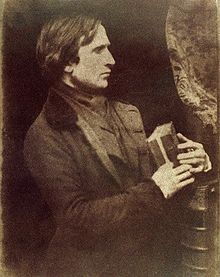Robert Adamson (photographer)
Robert Adamson | |
|---|---|
 Robert Adamson | |
| Born | 26 April 1821 |
| Died | 14 January 1848 (aged 26) |
| Nationality | Scottish |
| Years active | 1843−1847 |
| Known for | Early pioneer of photography |
Robert Adamson (26 April 1821 – 14 January 1848) was a
Early years

Adamson was born in St Andrews, one of ten children of Rachel Melville and Alexander Adamson, a Fife tenant farmer.[1][2] He grew up in Burnside and was educated at Madras College in St Andrews where he showed exceptional talents in mathematics and mechanics, twice winning the prize for mathematics. He became employed at an engineering shop from a young age,[2] and apprenticed as a millwright for several months.[3]
Career
Adamson was keen on becoming an engineer, but ill health led to him pursuing photography.
The young chemist,
The first studio specializing in calotypes in Edinburgh,[1] Adamson's studio practice was said to have been "confidential to the point of secrecy".[10] Hill required calotypes from which he would paint. Distinguished persons from many fields came to be photographed by the partners and within a few years they had taken the art scene by storm in Scotland.[5] Together they made around 2500 portraits,[11][12] some say 3000 or more,[2] and numerous views of Edinburgh between 1843 and 1848, exhibiting in 1844, 1845 and 1846.[12] Their prints were sold at the Princes Street gallery of Alexander Hill. After Hill and Adamson decided to publish their work, they purchased a specialised camera in 1844, but their plans to produce albums, paid by subscription, did not gain traction.[3]
Their depictions, in soft reddish-brown or sepia,[13] included local and Fife landscapes and urban scenes, including images of the Scott Monument, under construction in Edinburgh. They produced several groundbreaking "action" photographs of soldiers and – perhaps their most famous photograph – two priests walking side by side. Their depictions of groups and children were unrivaled.[3] As well as the great and the good, they photographed ordinary working folk, particularly the fishermen of Newhaven and their wives. Their social documentary series on Newhaven fishing families, which depicted living conditions and community relationships, was to be the most notable work of the partnership.[14]

By mid-1847, the studio stopped production due to the failing health of Adamson. Thinking to recuperate amidst his family, Adamson returned to St Andrews. He died of tuberculosis on 14 January 1848, at the age of 26.[3][15]
In 1851, the works of Hill & Adamson's appeared at
Partial works
- Miss Justine Munro
- Miss Grizzel Baillie, Scotland
- Mrs. Barbara (Johnstone) Flucker Opening Oysters
- Bringing in the catch
- Officer of the 92nd Gordon Highlanders Reading to the Troops, Edinburgh Castle
- The Fairy Tree at Colinton
- The Gowan
- The Minnow Pool
- The Rev. Dr. Jabez Bunting, Scotland
- Dumbarton Presbytery
- Willie Liston Redding the Line
References
- ^ a b c Hill, David Octavius; Adamson, Robert; Ovenden, Graham (1973). Hill & Adamson photographs. Academy Editions. p. 6. Retrieved 17 July 2012.
- ^ doi:10.1093/ref:odnb/41127. (Subscription or UK public library membershiprequired.)
- ^ Kraus, Jr., Hans P. (c. 1987). Sun pictures. Hans P. Kraus, Jr., Inc. p. 30. Retrieved 17 July 2012.
- ^ ISBN 978-0-89236-707-8. Retrieved 17 July 2012.
- ISBN 978-0-240-51483-3. Retrieved 1 August 2012.
- ISBN 978-0-89236-540-1. Retrieved 17 July 2012.
- ISBN 978-0-919863-28-6. Retrieved 17 July 2012.
- ISBN 978-0-89104-010-1. Retrieved 17 July 2012.
- ISBN 978-0-903598-15-6. Retrieved 17 July 2012.
- ^ Hutchinson Encyclopedia (1988), p.10
- ^ ISBN 9780902989009. Retrieved 17 July 2012.
- ^ ISBN 978-0-8131-2175-8. Retrieved 1 August 2012.
- ^ Hannavy (2007), p. 659
- ^ "Robert Adamson Master of Photography".
